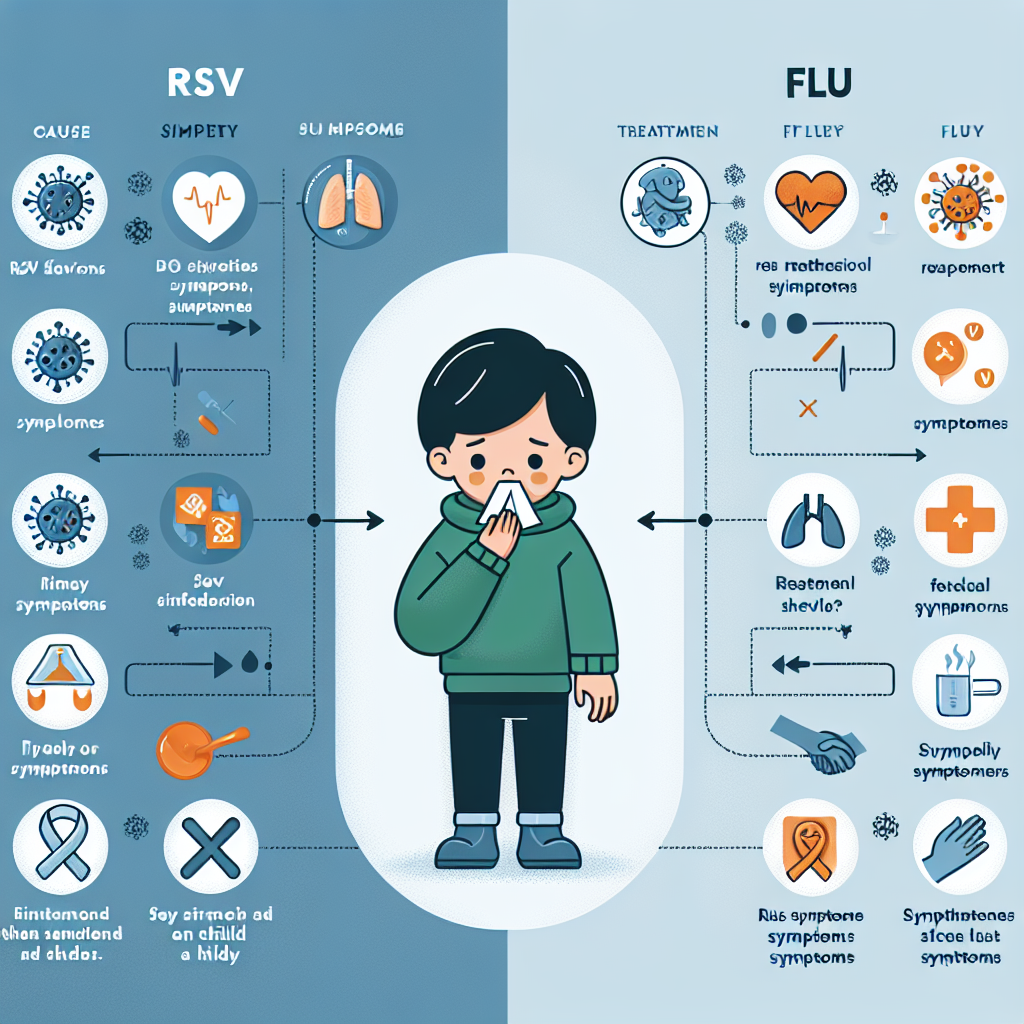In this informative article, you will gain a clear understanding of the key differentiating factors between RSV and flu symptoms in children. Whether you are a concerned parent or a healthcare professional, it is crucial to be able to identify these distinctions in order to provide the appropriate care and support for young patients. By highlighting the unique characteristics and manifestations of each illness, this article aims to equip you with the knowledge necessary to accurately recognize and respond to these common respiratory infections in children.

Basic Overview of RSV and Flu in Kids
Definition of RSV and Flu
RSV, or Respiratory Syncytial Virus, is a common respiratory infection that affects children, particularly those under the age of 2. It can cause mild symptoms similar to the common cold, but it can also lead to more severe respiratory distress in some cases. On the other hand, the flu, or influenza, is also a viral infection that affects the respiratory system and can cause mild to severe symptoms in children.
Common causes of RSV and Flu in kids
RSV is primarily spread through respiratory droplets, such as when an infected person coughs or sneezes. It can also be contracted by touching contaminated surfaces and then touching the face. The flu, on the other hand, is also spread through respiratory droplets, and it can be contracted by direct contact with an infected person or touching surfaces contaminated with the virus.
General Symptoms of RSV in Kids
Physical symptoms of RSV in children
Common physical symptoms of RSV in children include coughing, wheezing, runny nose, congestion, and a low-grade fever. In severe cases, RSV can lead to rapid and difficult breathing, cyanosis (bluish tint to the skin and lips), and poor feeding.
Behavioural symptoms of RSV in kids
Behavioural symptoms of RSV in kids may include irritability, decreased activity levels, and feeding difficulties. It is essential to monitor for these signs as they can indicate the severity of the infection.
General Symptoms of Flu in Kids
Physical symptoms of Flu in children
Children with the flu often experience a sudden onset of symptoms, including high fever, chills, body aches, headache, sore throat, and cough. They may also have a runny or stuffy nose, fatigue, and sometimes vomiting and diarrhea.
Behavioural symptoms of Flu in kids
Behavioural symptoms of the flu in kids can include irritability, restlessness, and decreased appetite. It is important to note that children with the flu may appear more ill and lethargic than those with RSV.

Specific Symptoms Differentiating RSV from Flu in Kids
What are unique indications of RSV?
While both RSV and the flu can cause respiratory symptoms, RSV is more likely to cause lower respiratory tract infections, such as bronchiolitis and pneumonia. Wheezing, rapid or difficult breathing, and signs of respiratory distress are more common in RSV infections.
What are unique indications of Flu?
The flu often presents with a sudden onset of symptoms and a higher fever compared to RSV. Nausea, vomiting, and diarrhea are more commonly associated with the flu rather than RSV. The presence of body aches, headache, and sore throat is also more indicative of the flu.
Severity and Duration of RSV and Flu in Kids
How severe can RSV and Flu get in kids?
Both RSV and the flu can cause severe illness in children, particularly in those with underlying health conditions and young infants. RSV can lead to complications such as pneumonia and respiratory failure, while the flu can result in complications like ear infections, sinusitis, and even life-threatening conditions like pneumonia and encephalitis.
How long do RSV and Flu typically last in kids?
RSV symptoms typically last for about 1 to 2 weeks, although some children may experience symptoms for a longer duration. In contrast, flu symptoms often resolve within a week, but fatigue and general malaise may persist for several weeks.
Complications that May Arise from RSV and Flu in Kids
Common complications from RSV in kids
RSV can lead to more severe respiratory infections, such as bronchiolitis and pneumonia, especially in infants and children with weakened immune systems. Children with pre-existing respiratory conditions like asthma may also experience exacerbations of their symptoms.
Common complications from Flu in kids
The flu can cause complications such as secondary bacterial infections, like pneumonia and sinusitis. In severe cases, it can result in complications like myocarditis (inflammation of the heart), encephalitis (inflammation of the brain), and even death.
Diagnosis of RSV and Flu in Kids
Common diagnostic procedures for RSV in kids
The diagnosis of RSV is usually based on clinical symptoms and the patient’s medical history. In some cases, a nasal swab may be taken to test for the presence of the virus. Additionally, a chest X-ray may be performed to evaluate the extent of lung involvement if the symptoms are severe.
Common diagnostic procedures for Flu in kids
Similar to RSV, the diagnosis of the flu is primarily based on clinical symptoms and the child’s medical history. A nasal or throat swab may be collected to confirm the presence of the influenza virus. Rapid diagnostic tests can provide quick results, while more specific tests like polymerase chain reaction (PCR) can be used for definitive diagnosis.
Treatment Methods for RSV and Flu in Kids
Standard treatment options for RSV in kids
Treatment for RSV is mainly supportive, focusing on relieving symptoms and ensuring proper hydration. In severe cases, hospitalization may be required to provide supplemental oxygen and monitoring of respiratory function. Antiviral medications may be used in certain high-risk cases.
Standard treatment options for Flu in kids
For uncomplicated cases of the flu, treatment involves rest, hydration, and symptom management, such as with over-the-counter pain relievers and fever reducers. Antiviral medications like oseltamivir (Tamiflu) may be prescribed for severe or high-risk cases to reduce the duration and severity of symptoms.
How to manage symptoms at home
To manage symptoms at home, it is essential to ensure proper rest, hydration, and nutrition for the child. Over-the-counter medications can be used to alleviate discomfort, but it is crucial to follow the appropriate dosage guidelines and consult a healthcare professional if symptoms worsen or persist.
Prevention Strategies for RSV and Flu in Kids
Recommended vaccines for RSV and Flu in kids
Prevention of RSV can be achieved through the administration of a monthly injection called palivizumab (Synagis) during the RSV season for high-risk infants. Vaccination against the flu is recommended annually for all children aged six months and older.
Best practices to avoid the spread of RSV and Flu
To reduce the spread of RSV and the flu, it is important to practice good hand hygiene by washing hands frequently with soap and water or using hand sanitizers. Avoiding close contact with sick individuals, covering the mouth and nose when coughing or sneezing, and regularly disinfecting commonly touched surfaces can also help minimize transmission.
When to Seek Professional Medical Help
Indications that RSV or Flu may require hospital attention
Seek professional medical help if your child with RSV or the flu experiences severe respiratory distress, such as rapid breathing, chest retractions, or bluish discoloration of the lips and nails. In infants, any signs of dehydration, lethargy, or difficulty feeding should also prompt medical attention.
Why timely medical intervention is crucial
Timely medical intervention is crucial because RSV and the flu can progress rapidly and lead to severe complications, especially in young children with weakened immune systems. Prompt medical care can help prevent further deterioration and provide appropriate treatment to alleviate symptoms and reduce the risk of complications.
In conclusion, RSV and the flu are both viral respiratory infections that can cause significant symptoms in children. While they share some similarities in terms of symptoms, there are also unique indications that can help differentiate between the two. Understanding the differences between RSV and the flu, recognizing the severity and duration of each infection, and knowing when to seek medical help can aid in timely management and prevention of complications. By implementing preventive strategies and following recommended vaccination guidelines, parents can play a crucial role in protecting their children from these respiratory illnesses.

